Oxidation Driven Damage on SiC/BN/SiC Ceramic Matrix Composite Aero-Engine Structures: An Iterative Computational Framework
Abstract
1. Introduction
- ρ0c is the initial concentration of the element;
- ρc is the actual concentration of the element;
- pox partial pressure of oxygen;
- k0, R, n constants;
- T temperature.
2. Materials and Methods
2.1. Diffusivity Analysis via Thermal Analogy
- C is the moisture concentration;
- t is the time;
- x is the spatial coordinate (just one coordinate in this example);
- D is the diffusion coefficient (isotropic, in this example).
- ρ is the material density;
- k is the thermal conductivity;
- c is the specific heat.
2.2. Oxydation Diffusion Model Calibration
2.3. Iterative Procedure to Couple Stress and Diffusion Models
Assumptions
- ε is the Von Mises strain at each node.
3. Results and Discussion
4. Conclusions
Author Contributions
Funding
Institutional Review Board Statement
Informed Consent Statement
Data Availability Statement
Acknowledgments
Conflicts of Interest
References
- Gavalda Diaz, O.; Garcia Luna, G.; Liao, Z.; Axinte, D. The new challenges of machining Ceramic Matrix Composites (CMCs): Review of surface integrity. Int. J. Mach. Tools Manuf. 2019, 139, 24–36. [Google Scholar] [CrossRef]
- Karadimas, G.; Salonitis, K. Ceramic Matrix Composites for Aero Engine Applications—A Review. Appl. Sci. 2023, 13, 3017. [Google Scholar] [CrossRef]
- Royce, R. The Jet Engine, 5th ed.; Wiley: Hoboken, NJ, USA, 2015. [Google Scholar]
- Rezazadeh Reyhani, M.; Alizadeh, M.; Fathi, A.; Khaledi, H. Turbine blade temperature calculation and life estimation—A sensitivity analysis. Propuls. Power 2013, 2, 148–161. [Google Scholar] [CrossRef]
- DiCarlo, J.A. Advances in SiC/SiC Composites for Aero-Propulsion, in Ceramic Matrix Composites: Materials, Modelling and Technology; Wiley: Hoboken, NJ, USA, 2015. [Google Scholar]
- Canale, G.; Rubino, F.; Citarella, R. Design aspects of a CMC coating-like system for hot surfaces of aero engine components. Forces Mech. 2024, 14, 100251. [Google Scholar] [CrossRef]
- Medford, J.E. Prediction of oxidation performance of reinforced carbon-carbon material for space shuttle leading edge. In Proceedings of the 10th AIAA Thermophysics Conference, Denver, CO, USA, 27–29 May 1975; AIAA Paper No. 75-730. AIAA: Reston, VA, USA, 1975. [Google Scholar]
- Halbig, M.C. The Oxidation Kinetics of Continuous Carbon Fibres in a Cracked Ceramic Matrix Composite; NASA/TM-2001-210520; NASA: Washington, DC, USA, 2001.
- Chen, X.; Sun, Z.; Li, H. Modelling the effect of oxidation on the residual tensile strength of SiC/C/SiC mini-composites in stressed oxidizing environments. J. Mater. Sci. 2019, 55, 3388–3407. [Google Scholar] [CrossRef]
- Zhao, Y.; Chen, Y.; He, C. A damage-induced short-circuit diffusion model applied to the oxidation calculation of ceramic matrix composites (CMCs). Compos. Appl. Sci. Manuf. 2019, 127, 105621. [Google Scholar] [CrossRef]
- Sullivan, R.M. A model for the oxidation of carbon silicon carbide composite structures. Carbon 2004, 43, 275–285. [Google Scholar] [CrossRef]
- Guoqiang, Y.; Shi, X.; Wang, Y.; Du, J.; Ni, Z.; Gao, X.; Wang, F.; Song, Y. An equivalent diffusion coefficient model of the oxidation of ceramic matrix composites. Ceram. Int. 2021, 47, 20857–20866. [Google Scholar]
- ABAQUS 6.14; SIMULIA: Johnston, RI, USA, 2014.
- Detwiler, K.N.; Opila, E.J. Oxidation of SiC/BN/SiC ceramic matrix composites in dry and wet oxygen at intermediate temperatures. J. Eur. Ceram. Soc. 2022, 42, 4110–4120. [Google Scholar] [CrossRef]
- Manno, R. Micro-Scale Analysis of Progressive Damage in Ceramic Matrix Composites. Ph.D. Thesis, University of Bristol, Bristol, UK, 2022. [Google Scholar]
- Gouadec, G.; Colomban, P.; Bansal, N.P. Raman Study of Uncoated and p-BN/SiCCoated Hi-Nicalon Fiber Reinforced Celsian Matrix Composities; NASA/TM-2000-2104S6; NASA: Washington, DC, USA, 2000.
- Naslain, R.; Dugne, O.; Guette, A.; Sevely, J.; Brosse, C.R.; Rocher, J.; Cotteret, J. Boron Nitride Interphase in Ceramic-Matrix Composites. J. Am. Ceram. Soc. 1991, 74, 2482–2488. [Google Scholar] [CrossRef]
- Mital, S.K.; Arnold, S.M.; Murthy, P.L.N.; Bednarcyk, B.A.; Pineda, E.J. Modelling of Time-Dependent Strength Degradation of SiC/SiC Ceramic Matrix Composites via MAC/GMC Computer Code; NASA/TM-2018-219939; NASA: Washington, DC, USA, 2018.
- Quiney, Z.; Weston, E.; Nicholson, P.I.; Pattison, S.; Bache, M.R. Volumetric assessment of fatigue damage in a SiCf/SiC ceramic matrix composite via in situ X-ray computed tomography. J. Eur. Ceram. Soc. 2020, 40, 3788–3794. [Google Scholar] [CrossRef]
- Ojard, G.; Miller, R.; Gowayed, Y.; Chen, J.; Santhosh, U.; Ahmad, J.; John, R. Time-Dependent Response of mi SiC/SiC Composites Part 1: Standard Samples; US Air Force Research Laboratory Report AFRL-ML-WP-TP-2007-425; Air Force Research Laboratory: Wright-Patterson Air Force Base, OH, USA, 2007. [Google Scholar]
- Murthy, P.L.N.; Mital, S.K.; Gyekenyesi, J.Z.; Gyekenyesi, J.P. Reliability and Creep/Fatigue Analysis of a CMC Component; NASA Technical Report, NASA/TM—2007-214975; NASA: Washington, DC, USA, 2007.
- Santhosh, U.; Ahmad, J.; Ojard, G.; Smyth, I.; Gowayed, Y.; Jefferson, G. Effect of porosity on the nonlinear and time-dependent behaviour of Ceramic Matrix Composites. Compos. Part B 2020, 184, 107658. [Google Scholar] [CrossRef]
- Won, Y.J.; Kim, S.B.; Kwon, Y.J.; Park, S.S.; Cho, K.S. Oxidation behavior and corrosion properties of 2-GPa grade Co-reduced ultrahigh-strength stainless steel. J. Alloys Compd. 2023, 968, 171736. [Google Scholar] [CrossRef]
- Naslain, R.; Guette, A.; Rebillat, F.; Le Gallet, S.; Lamouroux, F.; Filipuzzi, L.; Louchet, C. Oxidation Mechanisms and Kinetics of SiC-Matrix Composites and Their Constituents. J. Mater. Sci. 2004, 39, 7303–7316. [Google Scholar] [CrossRef]
- Colomban, P.; Gouadec, G.; Mazerolles, L. Alkaline Corrosion of SiC and Carbon Fibers. A Raman and Electron Microscopy Study. In Proceedings of the 103th Annual American Ceramic Society Conference and Exposition, Indianapolis, IN, USA, 22–25 April 2001; The American Ceramic Society: Westerville, OH, USA; Volume 128, pp. 157–168. [Google Scholar] [CrossRef]
- Opila, E.J.; Hagan, J. Hot Corrosion of SiC/BN/SiC Composites; ECS Meeting Abstracts; The Electrochemical Society: Pennington, NJ, USA, 2015; Volume MA2015-01. [Google Scholar] [CrossRef]
- Guo, F.; Chen, X.; Yang, J.; Zhang, X.; Liao, C.; Hu, J.; Zhou, H.; Dong, S. Effects of molten Na2SO4 on wet oxidation behavior of SiCf/SiC composites above 1200 °C. J. Eur. Ceram. Soc. 2023, 43, 1366–1375. [Google Scholar] [CrossRef]
- LeBlanc, L.R.; LaPlante, G. Experimental investigation and finite element modelling of mixed-mode delamination in a moisture-exposed carbon/epoxy composite. Compos. Part A Appl. Sci. Manuf. 2016, 81, 202–213. [Google Scholar] [CrossRef]
- Canale, G.; Kinawy, M.; Sathujoda, P.; Maligno, A.; Citarella, R.G. Moisture absorption in thick composite plates: Modelling and experiments. Multidiscip. Model. Mater. Struct. 2020, 16, 439–447. [Google Scholar] [CrossRef]
- Alabdullah, M.; Ghoniem, N.M. Damage mechanics modeling of the non-linear behavior of SiC/SiC ceramic matrix composite fuel cladding. J. Nucl. Mater. 2019, 524, 296–311. [Google Scholar] [CrossRef]
- Chaboche, J.L.; Lesne, P.M.; Maire, J.F. Continuum Damage Mechanics, Anisotropy and Damage Deactivation for Brittle Materials Like Concrete and Ceramic Composites. Int. J. Damage Mech. 1995, 4, 5–22. [Google Scholar] [CrossRef]
- Li, S. The Maximum Stress Failure Criterion and the Maximum Strain Failure Criterion: Their Unification and Rationalization. J. Compos. Sci. 2020, 4, 157. [Google Scholar] [CrossRef]




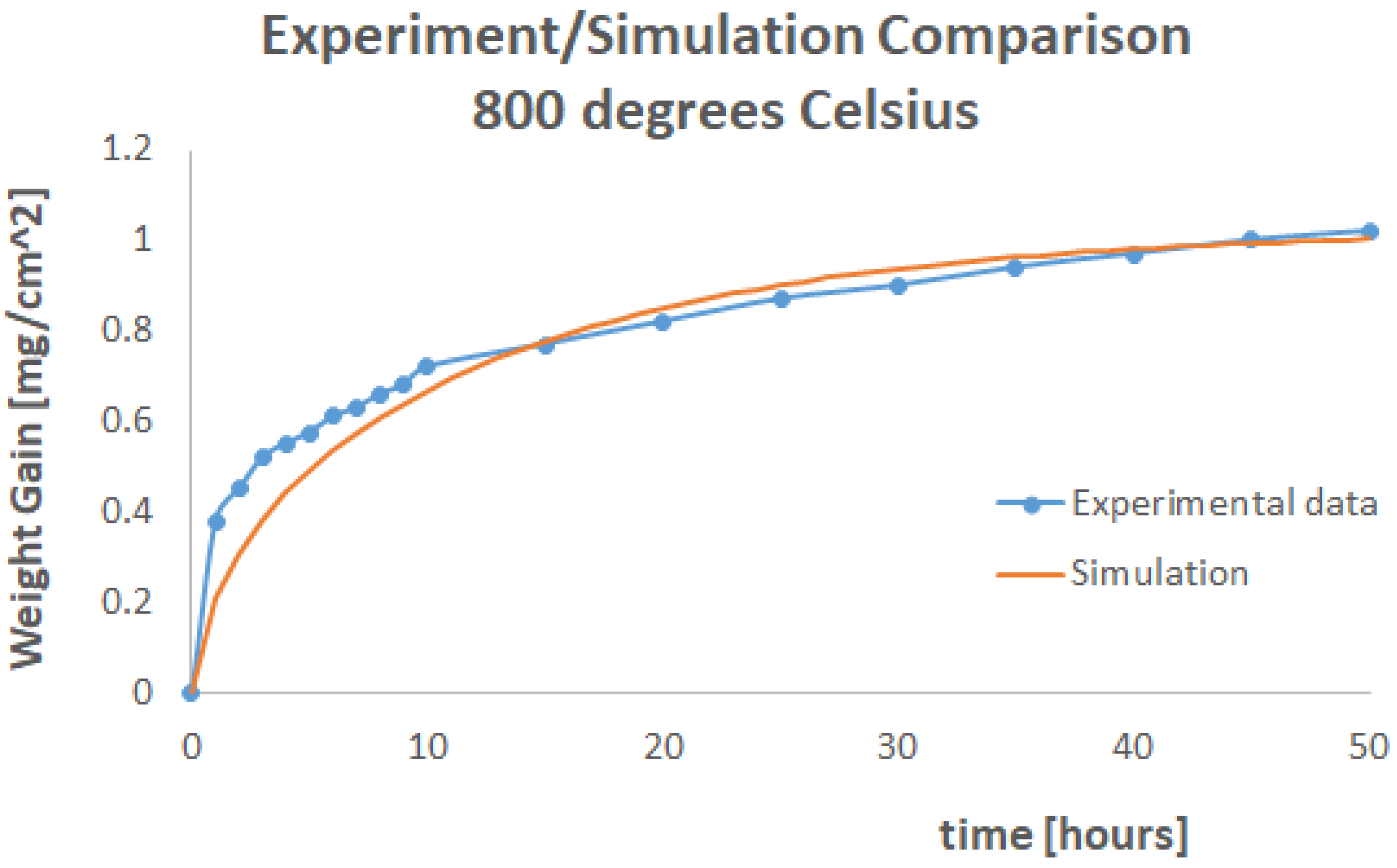


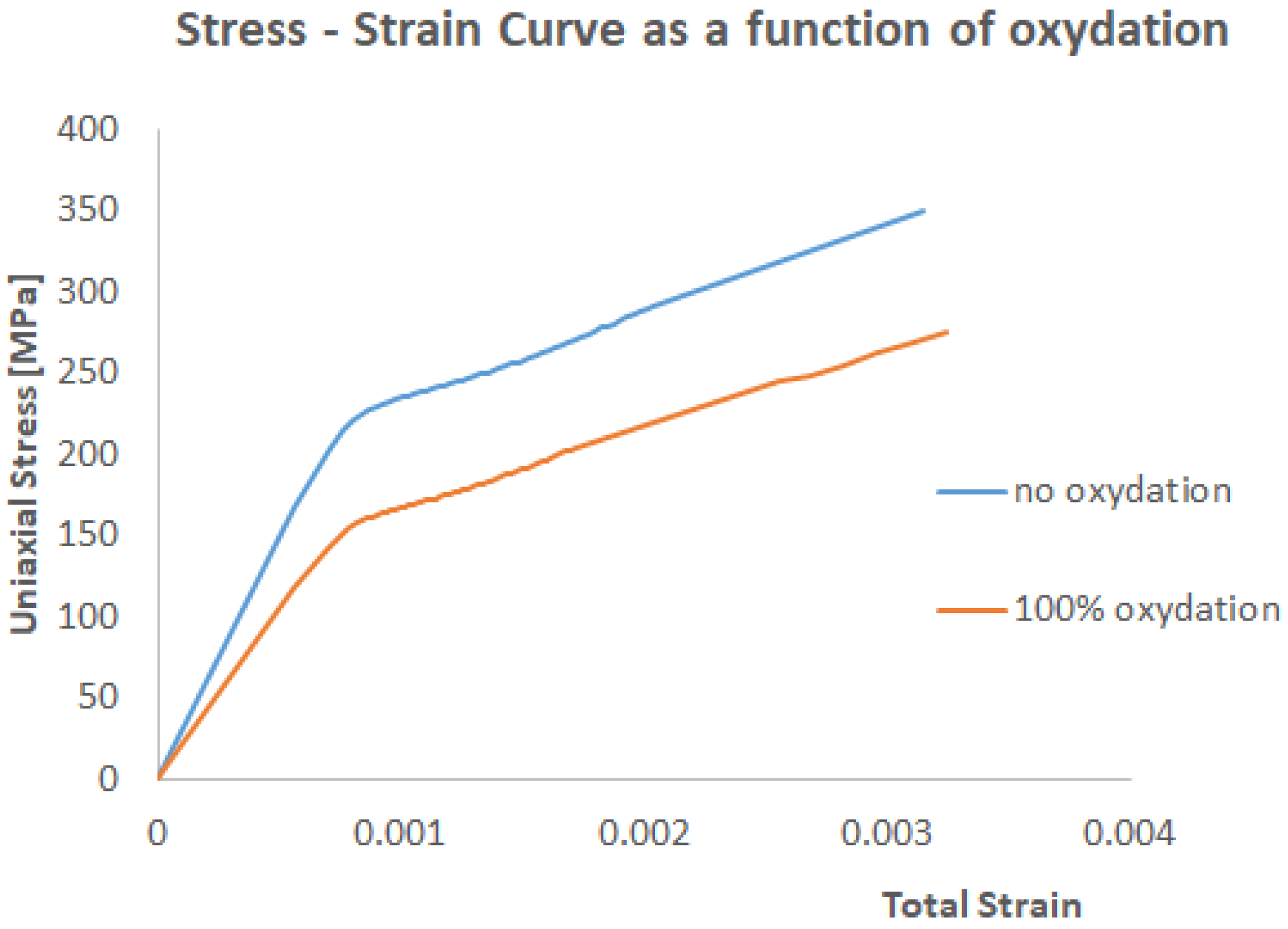

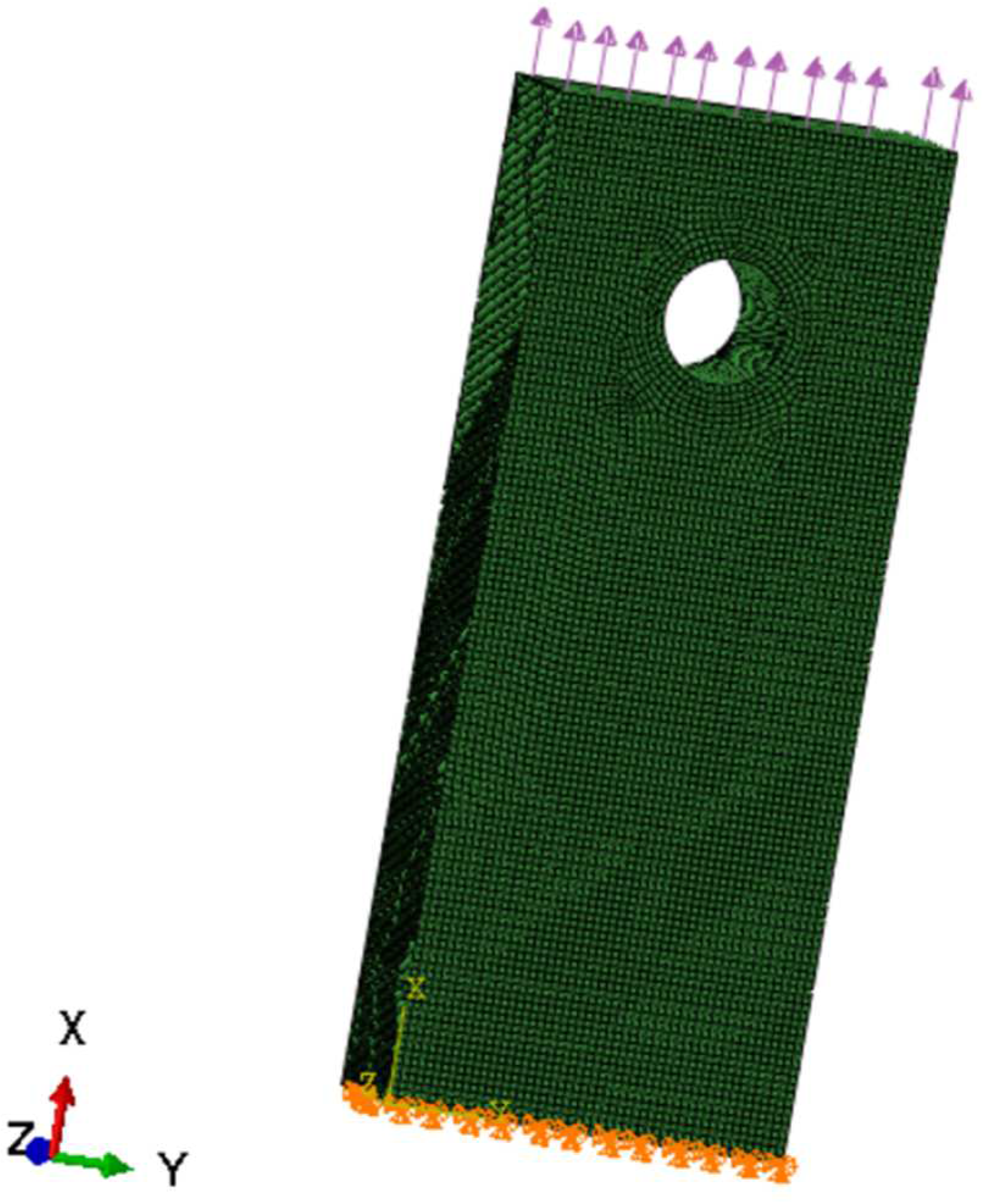
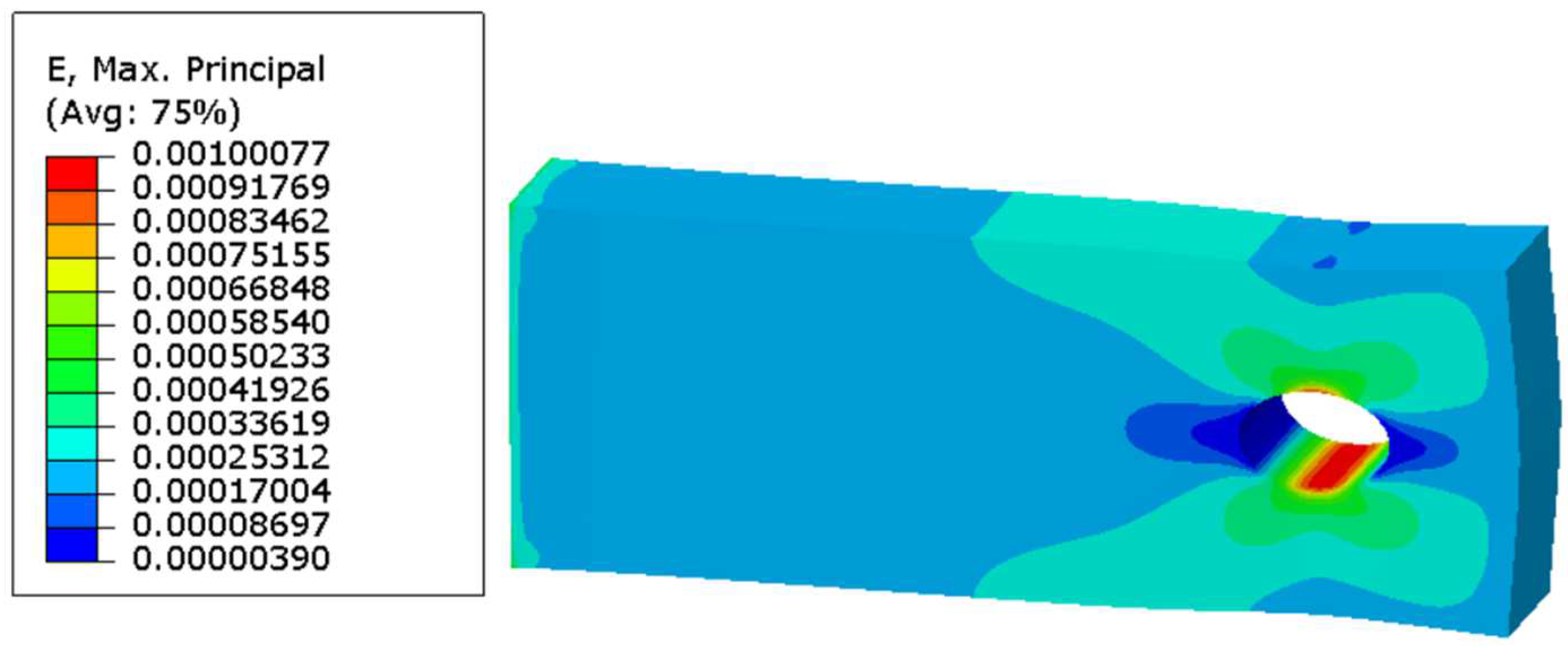
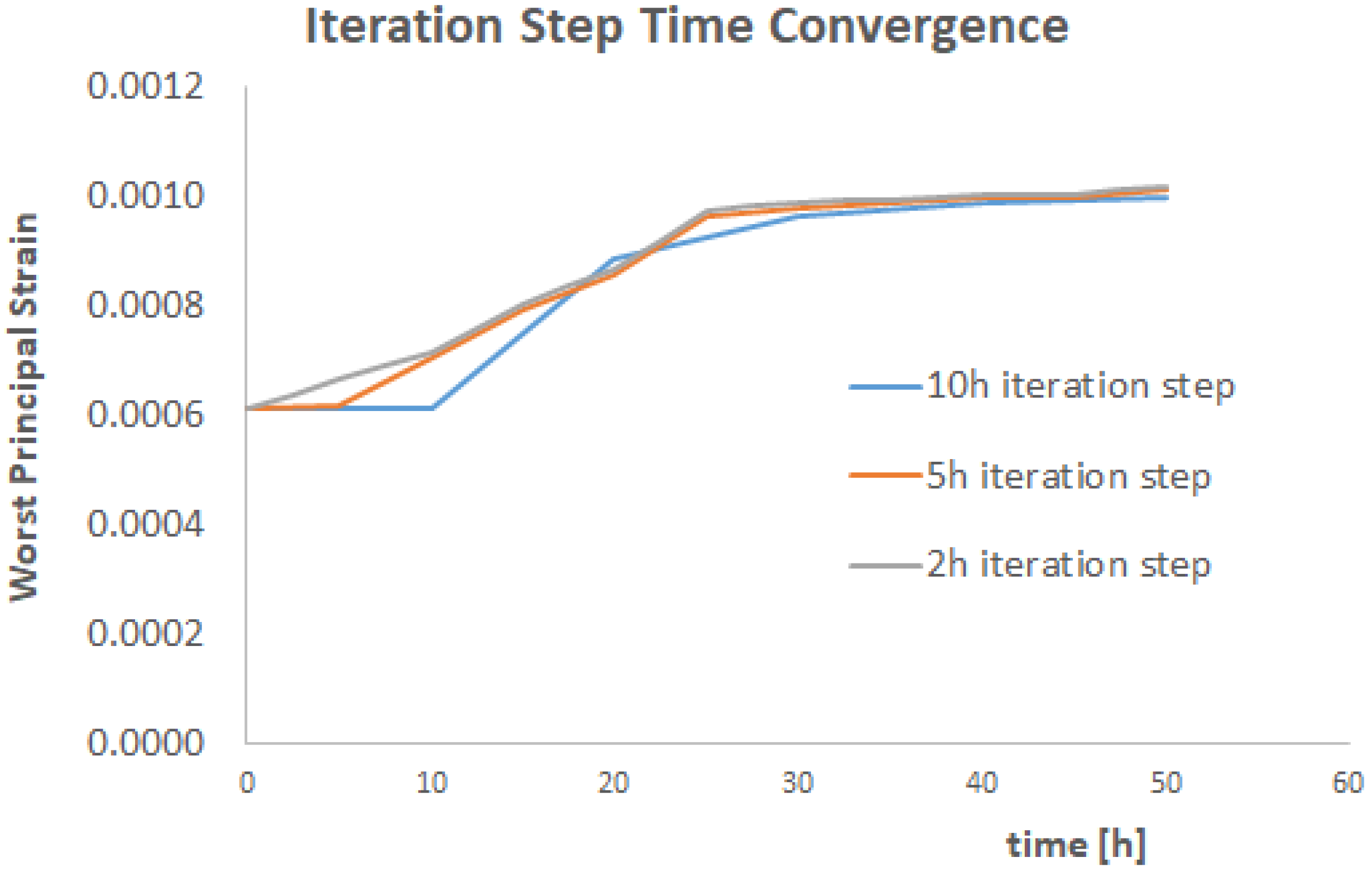
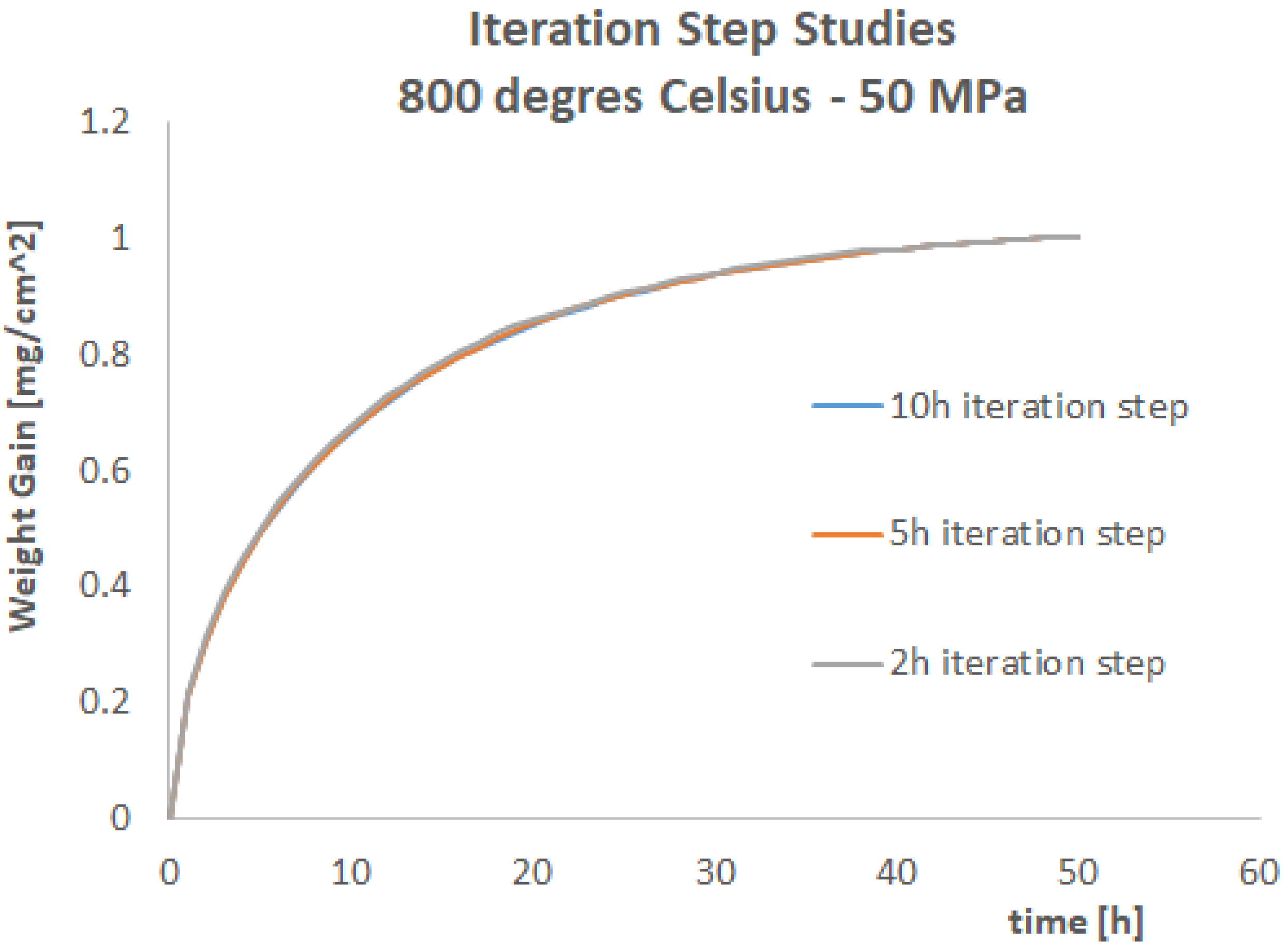

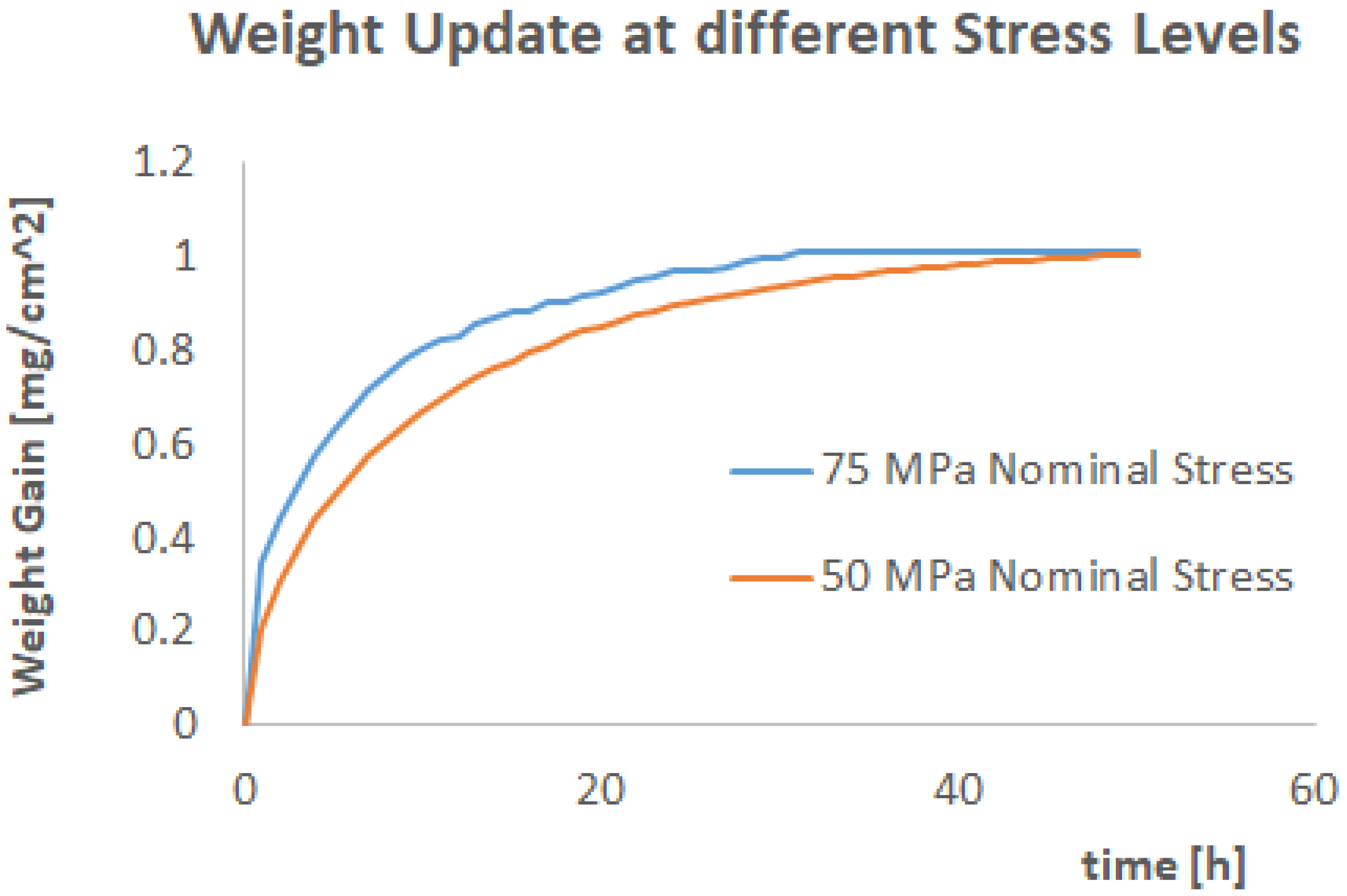
| E11 [MPa] | E22 [MPa] | E22 [MPa] |
|---|---|---|
| 300,000 | 300,000 | 260,000 |
| G12 [MPa] | G13 [MPa] | G23 [MPa] |
| 140,000 | 120,000 | 120,000 |
| v12 | v13 | v23 |
| 0.15 | 0.15 | 0.15 |
| ρ [Tons/mm3] | ||
| 2.8 × 10−9 |
| Elastic Property (t = 0 h) | 0–20% Oxygen | 100% Oxygen |
|---|---|---|
| E11 | 300,000 | 240,000 |
| E22 | 300,000 | 240,000 |
| E33 | 260,000 | 208,000 |
| G12 | 140,000 | 112,000 |
| G13 | 120,000 | 96,000 |
| G23 | 120,000 | 96,000 |
| Elastic Property (t = 20 h) | 0–20% Oxygen | 100% Oxygen |
|---|---|---|
| E11 | 300,000 | 204,000 |
| E22 | 300,000 | 204,000 |
| E33 | 260,000 | 176,800 |
| G12 | 140,000 | 95,200 |
| G13 | 120,000 | 81,600 |
| G23 | 120,000 | 81,600 |
| Oxygen Content Dependency t = 0 h | Stress [MPa] 0–20% Oxygen | Plastic Strain 0–20% Oxygen | Stress [MPa] 100% Ox | Plastic Strain 100% Oxygen |
|---|---|---|---|---|
| 167 | 0 | 134 | 0 | |
| 350 | 0.0013839 | 280 | 0.0013839 |
| Oxygen Content Dependency t = 20 h | Stress [MPa] 0–20% Oxygen | Plastic Strain 0–20% Oxygen | Stress [MPa] 100% Ox | Plastic Strain 100% Oxygen |
|---|---|---|---|---|
| 167 | 0 | 114 | 0 | |
| 350 | 0.0013839 | 240 | 0.0013839 |
| Conductivity [mW/mm/K] | Damage |
|---|---|
| 0.10 | 0 |
| 0.10 | 0.2 |
| 0.17 | 1 |
Disclaimer/Publisher’s Note: The statements, opinions and data contained in all publications are solely those of the individual author(s) and contributor(s) and not of MDPI and/or the editor(s). MDPI and/or the editor(s) disclaim responsibility for any injury to people or property resulting from any ideas, methods, instructions or products referred to in the content. |
© 2024 by the authors. Licensee MDPI, Basel, Switzerland. This article is an open access article distributed under the terms and conditions of the Creative Commons Attribution (CC BY) license (https://creativecommons.org/licenses/by/4.0/).
Share and Cite
Canale, G.; Citarella, R. Oxidation Driven Damage on SiC/BN/SiC Ceramic Matrix Composite Aero-Engine Structures: An Iterative Computational Framework. Materials 2024, 17, 3034. https://doi.org/10.3390/ma17123034
Canale G, Citarella R. Oxidation Driven Damage on SiC/BN/SiC Ceramic Matrix Composite Aero-Engine Structures: An Iterative Computational Framework. Materials. 2024; 17(12):3034. https://doi.org/10.3390/ma17123034
Chicago/Turabian StyleCanale, Giacomo, and Roberto Citarella. 2024. "Oxidation Driven Damage on SiC/BN/SiC Ceramic Matrix Composite Aero-Engine Structures: An Iterative Computational Framework" Materials 17, no. 12: 3034. https://doi.org/10.3390/ma17123034
APA StyleCanale, G., & Citarella, R. (2024). Oxidation Driven Damage on SiC/BN/SiC Ceramic Matrix Composite Aero-Engine Structures: An Iterative Computational Framework. Materials, 17(12), 3034. https://doi.org/10.3390/ma17123034






